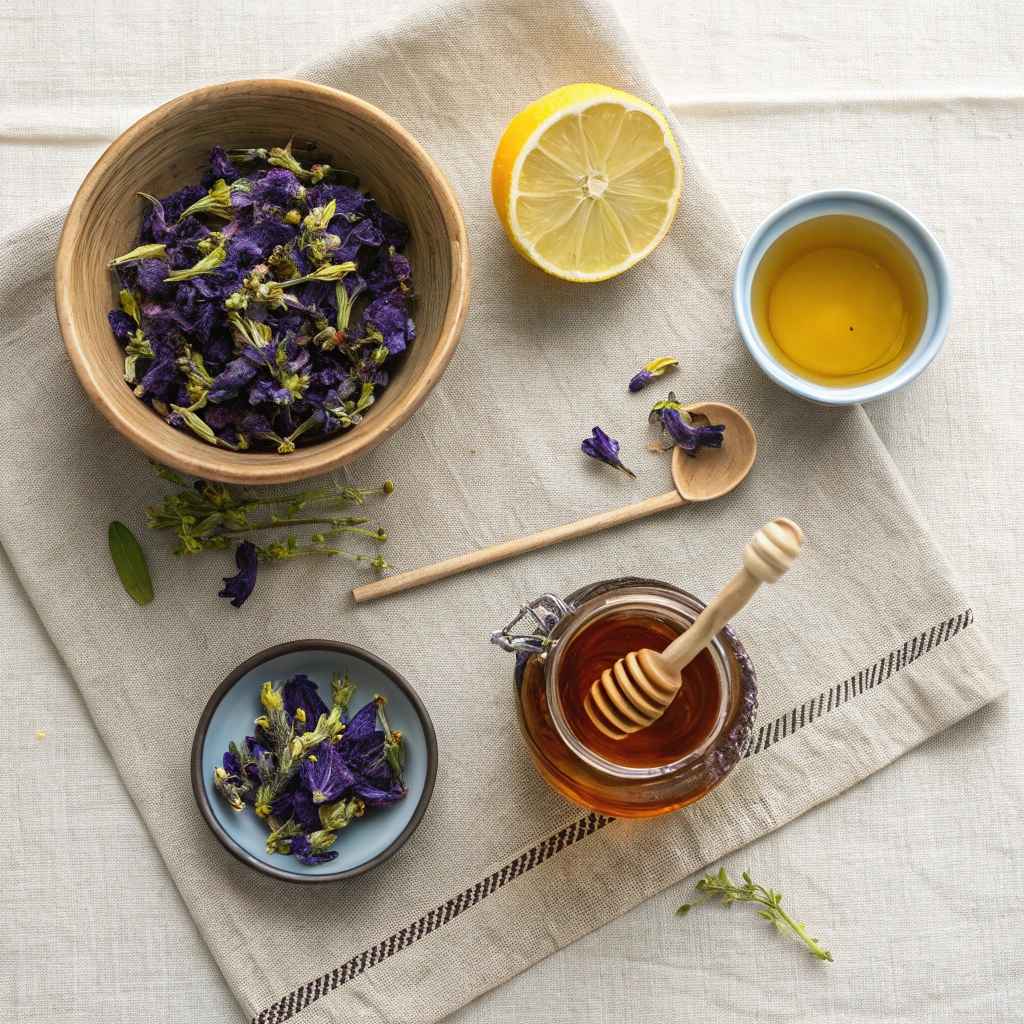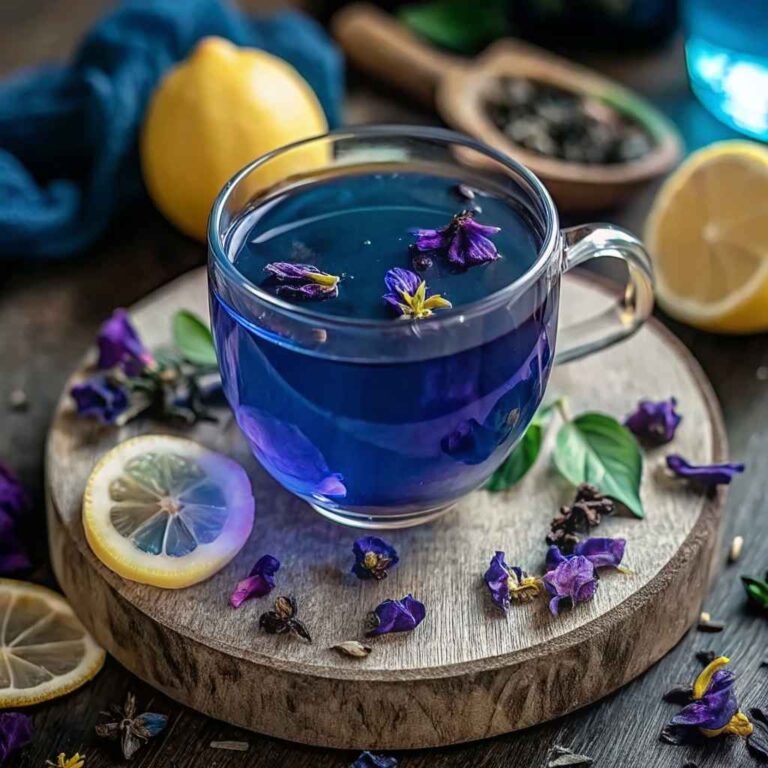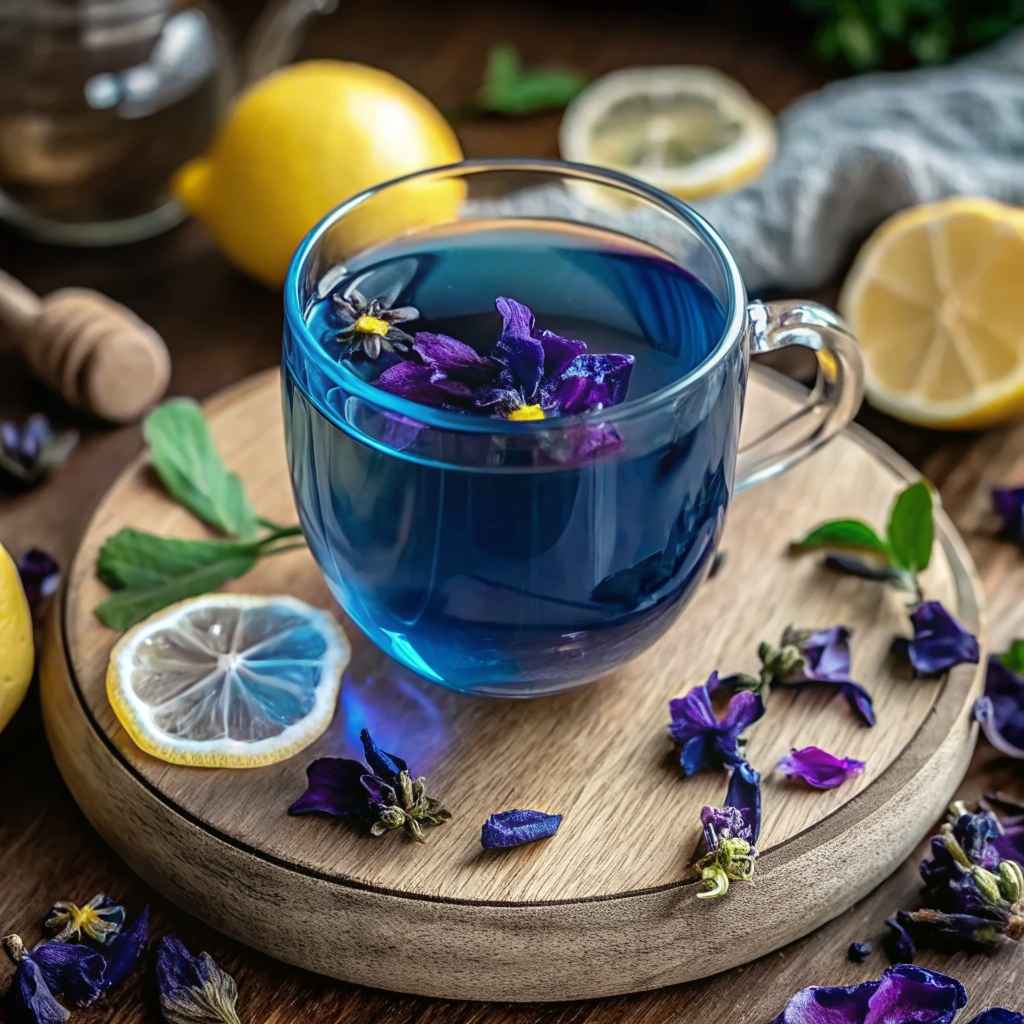The butterfly pea flower tea recipe is one of the most eye-catching and simple herbal infusions you can prepare at home. Known for its deep blue hue that shifts to purple with lemon, this drink is more than just pretty—it’s full of tradition and subtle flavor. If you’re searching for a unique herbal tea that looks great and offers calming benefits, this is the one to try. In this article, we’ll guide you through a butterfly pea flower tea recipe that’s easy, customizable, and perfect for everyday sipping. You’ll also learn about its flavor, health perks, how long to steep it, and smart additions to boost both taste and appeal.
Let’s start with the background and why this butterfly pea flower tea recipe is gaining so much attention.
Table of Contents
What is Butterfly Pea Flower Tea?
What is butterfly pea tea and where it comes from
A butterfly pea flower tea recipe begins with dried petals from the Clitoria ternatea plant. This tropical vine grows across Southeast Asia and is known for its intense blue flowers. When brewed in hot water, the petals create a deep indigo tea that’s caffeine-free and naturally colorful. The butterfly pea flower tea recipe is rooted in Thai and Malaysian traditions, where the tea is often used in rice dishes, drinks, and even beauty rituals.
More recently, this striking tea has made its way into American kitchens, especially for those who love creative food presentation. The butterfly pea flower tea recipe is popular not only for its unique look but also for its versatility—you can enjoy it hot, cold, sweetened, or mixed with lemon for a fun color change.
Butterfly pea flower tea health benefits and uses
This tea contains antioxidants, especially anthocyanins, which may help reduce free radicals. Some people use a butterfly pea flower tea recipe as part of their nighttime routine to promote calm and support digestion. Although scientific research is still developing, users of butterfly pea flower tea believe it may benefit hair, skin, and memory.
Because it reacts to pH changes, a butterfly pea flower tea recipe is perfect for kids’ science fun, natural cocktails, or colorful detox drinks. It’s a guilt-free way to hydrate without caffeine or sugar. Want something to enjoy alongside it? Serve this tea with our pink salt detox recipe or balance its floral taste with Earl Grey cookies for a cozy afternoon.
Ingredients Needed for Butterfly Pea Flower Tea
Essential ingredients for the perfect butterfly pea tea

Crafting the ideal butterfly pea flower tea recipe starts with just a few simple ingredients. The beauty of this tea lies in its minimalism—you don’t need complicated steps or hard-to-find items. Here’s what you’ll need for a basic recipe:
Print
Butterfly Pea Flower Tea Recipe
A naturally blue herbal tea made from dried butterfly pea flowers. This caffeine-free recipe is easy, colorful, and perfect for hot or iced drinks.
- Total Time: 12 minutes
- Yield: 1 serving 1x
Ingredients
-
5–7 dried butterfly pea flowers
-
1 cup hot water (190–200°F)
-
1 teaspoon honey or sweetener (optional)
-
1–2 teaspoons lemon juice (optional)
-
Ice cubes (optional for cold version)
Instructions
-
Heat water just below boiling (190–200°F).
-
Place butterfly pea flowers in a teapot or heatproof glass.
-
Pour hot water over the flowers and cover.

Step-by-step process of making butterfly pea flower tea -
Let steep for 5–7 minutes until vibrant blue.
-
Strain the flowers and discard.
-
Add honey or lemon juice to taste.
-
For iced tea, let cool and pour over ice.
-
Enjoy immediately or store in fridge for up to 2 days.
Notes
For stronger color, add more flowers or steep slightly longer. Lemon juice changes the color to purple or pink. You can freeze leftover tea into ice cubes for later use.
- Prep Time: 5 minutes
- Cook Time: 7 minutes
- Category: Drinks
- Method: Steeping
- Cuisine: Asian
Nutrition
- Serving Size: 1 cup
- Calories: 4
- Sugar: 0g
- Sodium: 2mg
- Fat: 0g
- Saturated Fat: 0g
- Unsaturated Fat: 0g
- Trans Fat: 0g
- Carbohydrates: 1g
- Fiber: 0g
- Protein: 0g
- Cholesterol: 0mg
Keywords: butterfly pea flower tea recipe, herbal tea, blue tea
Once you stock up, you can repurpose these flowers in more than tea. Add them to syrups, jellies, cocktails, or even homemade desserts. We’ve used them creatively in recipes like our matcha shortbread cookies and no-bake matcha chocolate berry cheesecake for a colorful twist.
How to Make Butterfly Pea Flower Tea (Step-by-Step Method)
Step-by-step method to brew butterfly pea tea
This butterfly pea flower tea recipe is easy to follow and requires only a few minutes. Whether you’re making it hot or iced, the process is the same, with a few optional tweaks for flavor and presentation.
Here’s how to prepare it:
- Boil water
Heat about 1 cup (240 ml) of filtered water until it reaches 190°F to 200°F. Avoid using boiling water, as it can make the tea taste bitter. - Add butterfly pea flowers
Use 5 to 7 dried butterfly pea flowers per cup. Place them in a heatproof glass, teapot, or French press. - Steep the tea
Pour the hot water over the flowers and let it steep for 5 to 7 minutes. The water will turn a vivid blue. You can steep longer for a deeper color. - Strain and serve
Remove the flowers using a strainer or filter. Serve the tea as is or add your preferred ingredients. - Customize your tea (optional)
Add a few drops of lemon or lime juice to watch the tea change to purple or pink. Stir in honey, agave, or maple syrup for sweetness. If you prefer a cold drink, pour the tea over ice or chill it in the fridge.
Common mistakes to avoid when preparing butterfly pea tea
To make sure your butterfly pea flower tea recipe turns out just right, here are common mistakes to avoid:
- Using boiling water – This can damage the delicate flowers and create a dull or bitter flavor.
- Over-steeping – More than 10 minutes can result in a musty taste.
- Using too few flowers – This leads to a weak color and watery tea.
- Skipping the straining – Leaving the petals in too long can change the flavor.
- Improper storage – Always store dried flowers in an airtight container away from heat and light.
For a colorful dessert pairing, try this tea with our flaky Filipino chicken empanada or cool off with a tropical treat like our no-bake coconut cream pie.
Butterfly Pea Tea Flavor and Appearance
What does butterfly pea tea taste like?
One of the most common questions about this drink is: What does butterfly pea tea taste like? Despite its bold color, the flavor is surprisingly subtle. The tea has a very light, earthy flavor with grassy undertones, similar to green tea but less astringent. Some people also describe it as mildly woody or floral, depending on how fresh the flowers are and how long they’re steeped.
This mild flavor makes butterfly pea flower tea an excellent base for other ingredients. It doesn’t overpower fruits, herbs, or sweeteners, so it works well in everything from herbal blends to cocktails and lattes.
If you’re expecting a bold or sweet flavor based on the intense blue color, you might be surprised. That’s why many butterfly pea flower tea recipes include lemon juice or honey—not just for health, but to brighten the taste.
Enjoy your tea with a soft slice of our Hokkaido milk bread or serve it alongside a Chinese bakery fruit sponge cake to balance the floral notes with soft sweetness.
Why does it change color and how to control it
Butterfly pea flower tea changes color due to its anthocyanin content—a group of natural pigments that react to pH levels. This chemical reaction creates the magic that many people love about the butterfly pea flower tea recipe.
Here’s how the color shift works:
| pH Level | Additive | Tea Color |
|---|---|---|
| Neutral (7) | Plain water | Deep blue |
| Acidic (<7) | Lemon, lime, vinegar | Purple to pink |
| Alkaline (>7) | Baking soda | Greenish blue |
To get consistent results, add acidic ingredients gradually while watching the color change in real time. This effect is especially popular in layered drinks and mocktails. You can even make color-changing ice cubes using butterfly pea tea and freeze them for cocktails or lemonades.
For a visual drink that really impresses, use your butterfly pea flower tea recipe to make layered iced drinks. Add blue tea over white coconut milk or combine with citrus juice for a dramatic ombré effect.
Best Additions to Enhance Butterfly Pea Tea
Fruits, herbs, and citrus for added flavor and effects
A great butterfly pea flower tea recipe doesn’t stop with just flowers and hot water. To boost flavor and visual appeal, you can add a wide variety of natural ingredients that complement the tea’s subtle floral base. Here’s what to add to butterfly pea tea to suit your taste and style:
1. Citrus – Lemon and lime are the most common additions. They not only enhance the flavor with a fresh, tangy twist but also trigger the tea’s famous color change from blue to purple or pink. Orange slices work too and add a gentle sweetness.
2. Fresh fruits – Blueberries, strawberries, and raspberries provide a fruity flavor and visual contrast. Drop a few into your glass or muddle them slightly for infused tea.
3. Herbs – Mint and basil are perfect if you want a more refreshing profile. A sprig of rosemary can add a pine-like depth, especially when paired with honey.
4. Ginger or lemongrass – These add warmth and complexity. Use them in hot versions of the butterfly pea flower tea recipe for a cozy, comforting effect.
Natural sweeteners and optional mix-ins
Butterfly pea tea has a light, earthy flavor that pairs well with sweeteners. If you like your tea sweet, but still want to keep it healthy, here are some options:
- Raw honey – Adds richness and depth
- Maple syrup – Works great with lemon or ginger
- Stevia or monk fruit – Ideal for low-carb diets
- Agave nectar – A neutral, vegan-friendly choice
You can also turn your butterfly pea flower tea recipe into a creamy drink by adding coconut milk, almond milk, or oat milk. When layered with ice and lemon juice, the result is an ombré tea latte that looks straight out of a café.
Looking for snacks to go with your tea? Try our nutty, umami-packed sesame peanut tossed noodles or a naturally sweet option like these vegan banana nut blondies.
Serving Ideas for Butterfly Pea Tea
Chilled, hot, and cocktail-style presentations
Once you’ve brewed your butterfly pea flower tea recipe, how you serve it makes a huge difference. Thanks to its vibrant color and pH-sensitive nature, this tea becomes the centerpiece of any drink spread.
Hot tea:
Serve your butterfly pea tea in a clear glass mug to show off the bold color. Add a slice of lemon on the rim for a touch of elegance and a pop of acidity.
Iced tea:
For a chilled option, let the tea cool and pour it over ice. Add a splash of citrus or a swirl of coconut milk for an ombré look. This version is ideal for warm weather and visually stunning when served in tall glasses.
Butterfly pea tea cocktails and mocktails:
This tea makes a striking base for colorful drinks. Try mixing butterfly pea flower tea with lemonade, soda water, or even sparkling wine for a natural cocktail. Want an alcohol-free mocktail? Combine it with pomegranate juice or lychee syrup for layers of color and flavor.
Pro tip: Freeze brewed tea into ice cubes. Drop them into clear drinks and watch the hues swirl as they melt.
Pair your tea with creative snacks like our chewy Korean sesame mochi bread or try something bold and fun like our viral fried chicken ice cream for guests who love unexpected combos.
Creative ways to serve at parties or special occasions
The butterfly pea flower tea recipe is a party trick in itself. Its color-shifting magic makes it ideal for special events like birthdays, showers, or themed dinners.

Here are a few party-ready serving ideas:
- Color-layered drinks: Use a straw to layer lemon juice or juice concentrate slowly over the tea to create a purple-blue gradient.
- Butterfly pea punch bowl: Brew a large batch and add citrus slices, berries, and edible flowers.
- Frozen tea pops: Freeze the tea with lemon juice in popsicle molds for a colorful, refreshing dessert.
You can also use this tea to tint other dishes. Use it to color jelly, tapioca pearls, or rice. The butterfly pea flower tea recipe becomes a base not just for drinks, but for edible art.
Safety Tips and Who Should Avoid It
Who should avoid butterfly pea flower tea?
Although the butterfly pea flower tea recipe is generally safe for most people, it’s important to know who may need to avoid or limit its use. Like all herbal teas, it can have mild effects on the body, and some individuals might be more sensitive to them.
Avoid this tea or talk to your doctor first if you:
- Are pregnant or breastfeeding: There’s limited research on butterfly pea flower’s effects during pregnancy. Traditional medicine discourages its use in early stages due to possible uterine stimulation.
- Take blood thinners or diabetes medication: Butterfly pea tea may slightly lower blood pressure and blood sugar. If you’re on related medication, consult your healthcare provider to avoid unwanted interactions.
- Have existing hormone-sensitive conditions: While rare, butterfly pea flower tea has mild estrogen-like properties. Anyone with hormone-related disorders should be cautious.
- Have known plant allergies: If you’re sensitive to legumes or herbal flowers, watch for any signs of allergy such as itching, swelling, or digestive upset after drinking.
For most healthy adults, drinking this tea in moderation is safe. Limit intake to one or two cups daily until you know how your body responds. If you’re ever unsure, it’s always better to check with a medical professional.
We follow similar safety awareness in recipes like our soft, fluffy jasmine rice guide and detailed instructions for treats like homemade fortune cookies—because good food should be enjoyable and safe.
How much is safe to drink daily
Moderation is key when it comes to herbal tea. The butterfly pea flower tea recipe is naturally caffeine-free, but its compounds still interact with the body. Drinking 1–2 cups per day is generally considered safe. If you’re drinking it daily for wellness, rotate with other herbal teas to avoid dependency on any one plant.
Also, be mindful when combining it with other herbs or strong ingredients like ginger, turmeric, or hibiscus. These blends may amplify health effects, both good and bad.
Use clean, high-quality flowers, steep for the recommended time, and store your tea correctly to avoid spoilage or mold growth. We’ll go over storage and steeping tips in the next section.
Storage, Shelf Life, and Steeping Guide
How long to steep butterfly pea tea for best taste
If you’re following a butterfly pea flower tea recipe and wondering how long to steep it, the sweet spot is between 5 to 7 minutes. This range allows the dried butterfly pea flowers to fully release their blue pigment and mild, earthy flavor without becoming bitter.
Here’s a quick guide:
| Steeping Time | Result |
|---|---|
| 1–3 minutes | Very light color, subtle flavor |
| 5–7 minutes | Bold blue, balanced taste |
| 8+ minutes | Over-extracted, woody notes |
Use hot water just below boiling (around 190–200°F) and cover your mug or teapot during steeping to trap heat and aroma. If you’re brewing for iced tea, allow the tea to cool before pouring it over ice to avoid dilution.
This steeping range works whether you’re using loose butterfly pea flowers or pre-measured tea bags. Just make sure the flowers have room to expand and infuse properly.
Need something to pair while you wait for steeping? Try this soothing Chinese creamy walnut dessert soup or a crunchy, fun snack like the Panda Express fortune cookie.
Storage tips for dried flowers and brewed tea
The quality of your butterfly pea flower tea recipe depends heavily on proper storage. Whether you’re keeping dried flowers or leftover brewed tea, follow these tips to preserve freshness:
For dried butterfly pea flowers:
- Store in an airtight container
- Keep in a cool, dry place away from sunlight
- Avoid humidity and strong odors, which may affect the taste
Properly stored, dried butterfly pea flowers can last up to 12 months without losing their color or aroma. Always check for signs of mold or an off-smell before using.
For brewed butterfly pea tea:
- Refrigerate immediately after brewing if not drinking right away
- Store in a sealed glass bottle or jar
- Use within 2 to 3 days for best taste
You can also freeze the brewed tea into ice cubes and use them later in drinks for a quick burst of color and chill.
These storage methods ensure every butterfly pea flower tea recipe you make will deliver the same striking color and smooth flavor—whether it’s your first cup or your fiftieth.
FAQs About Butterfly Pea Flower Tea Recipe
How long to steep butterfly pea tea?
The best steeping time for a butterfly pea flower tea recipe is 5 to 7 minutes. This range brings out the vibrant color and mild floral taste. Over-steeping beyond 10 minutes may result in a woody or earthy flavor that overpowers the tea. Use hot water just under boiling (190–200°F) for best results, and cover the cup while steeping to preserve aroma.
Who should avoid butterfly pea flower tea?
While the butterfly pea flower tea recipe is safe for most, some people should proceed with caution. Those who are pregnant, breastfeeding, or taking blood pressure or diabetes medications should consult a doctor. The tea may interact with medications due to its potential to lower blood sugar and blood pressure slightly. If you have any herbal allergies, start with a small amount and monitor your reaction.
How does butterfly pea tea taste like?
Don’t be fooled by its bright blue color—the butterfly pea flower tea recipe produces a mild, earthy flavor with soft grassy notes. It’s not bitter or sweet by default, which makes it a great base for citrus, honey, and herbal add-ins. When lemon or lime is added, the taste becomes tangier and more vibrant.
What to add to butterfly pea tea?
Enhance your butterfly pea flower tea recipe with lemon juice, mint, fresh fruits, or natural sweeteners like honey or agave. Adding citrus not only improves the flavor but also changes the color to purple or pink due to pH reaction. Some also mix it with coconut milk or soda water for a unique layered drink.
Conclusion
The butterfly pea flower tea recipe is more than a trendy drink—it’s a unique experience that combines beauty, tradition, and wellness in one vibrant cup. From its brilliant blue hue to the pH-powered color shifts, this tea offers endless ways to customize, serve, and enjoy it.
With just a few dried flowers, hot water, and your favorite add-ins, you can make a soothing drink that feels special without being complicated. Whether you sip it warm on a quiet morning or serve it chilled with fruit for guests, this butterfly pea flower tea recipe is always a conversation starter.
Now that you know how to make it, how to store it, and what to add, you’re ready to brew your own cup with confidence. Be sure to experiment and find your favorite combination—because tea should taste as good as it looks.
Want to share your brewing results or ask a question? Feel free to connect with us on Facebook.

